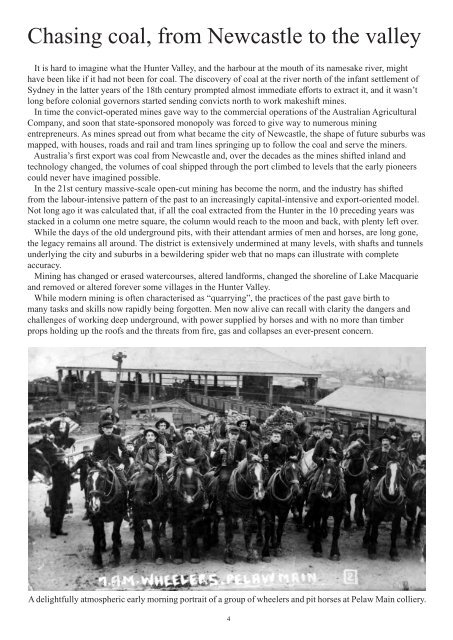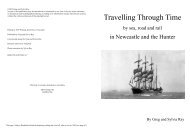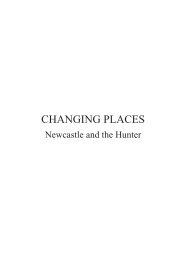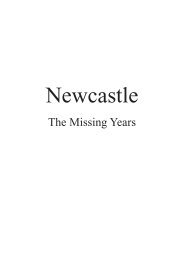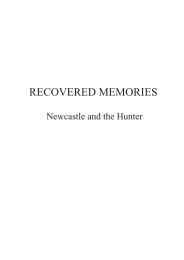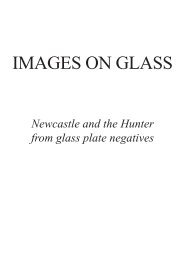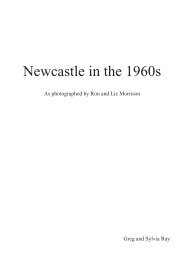the way we worked
You also want an ePaper? Increase the reach of your titles
YUMPU automatically turns print PDFs into web optimized ePapers that Google loves.
Chasing coal, from Newcastle to <strong>the</strong> valley<br />
It is hard to imagine what <strong>the</strong> Hunter Valley, and <strong>the</strong> harbour at <strong>the</strong> mouth of its namesake river, might<br />
have been like if it had not been for coal. The discovery of coal at <strong>the</strong> river north of <strong>the</strong> infant settlement of<br />
Sydney in <strong>the</strong> latter years of <strong>the</strong> 18th century prompted almost immediate efforts to extract it, and it wasn’t<br />
long before colonial governors started sending convicts north to work makeshift mines.<br />
In time <strong>the</strong> convict-operated mines gave <strong>way</strong> to <strong>the</strong> commercial operations of <strong>the</strong> Australian Agricultural<br />
Company, and soon that state-sponsored monopoly was forced to give <strong>way</strong> to numerous mining<br />
entrepreneurs. As mines spread out from what became <strong>the</strong> city of Newcastle, <strong>the</strong> shape of future suburbs was<br />
mapped, with houses, roads and rail and tram lines springing up to follow <strong>the</strong> coal and serve <strong>the</strong> miners.<br />
Australia’s first export was coal from Newcastle and, over <strong>the</strong> decades as <strong>the</strong> mines shifted inland and<br />
technology changed, <strong>the</strong> volumes of coal shipped through <strong>the</strong> port climbed to levels that <strong>the</strong> early pioneers<br />
could never have imagined possible.<br />
In <strong>the</strong> 21st century massive-scale open-cut mining has become <strong>the</strong> norm, and <strong>the</strong> industry has shifted<br />
from <strong>the</strong> labour-intensive pattern of <strong>the</strong> past to an increasingly capital-intensive and export-oriented model.<br />
Not long ago it was calculated that, if all <strong>the</strong> coal extracted from <strong>the</strong> Hunter in <strong>the</strong> 10 preceding years was<br />
stacked in a column one metre square, <strong>the</strong> column would reach to <strong>the</strong> moon and back, with plenty left over.<br />
While <strong>the</strong> days of <strong>the</strong> old underground pits, with <strong>the</strong>ir attendant armies of men and horses, are long gone,<br />
<strong>the</strong> legacy remains all around. The district is extensively undermined at many levels, with shafts and tunnels<br />
underlying <strong>the</strong> city and suburbs in a bewildering spider <strong>we</strong>b that no maps can illustrate with complete<br />
accuracy.<br />
Mining has changed or erased watercourses, altered landforms, changed <strong>the</strong> shoreline of Lake Macquarie<br />
and removed or altered forever some villages in <strong>the</strong> Hunter Valley.<br />
While modern mining is often characterised as “quarrying”, <strong>the</strong> practices of <strong>the</strong> past gave birth to<br />
many tasks and skills now rapidly being forgotten. Men now alive can recall with clarity <strong>the</strong> dangers and<br />
challenges of working deep underground, with po<strong>we</strong>r supplied by horses and with no more than timber<br />
props holding up <strong>the</strong> roofs and <strong>the</strong> threats from fire, gas and collapses an ever-present concern.<br />
A delightfully atmospheric early morning portrait of a group of wheelers and pit horses at Pelaw Main colliery.<br />
4


